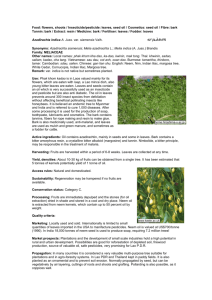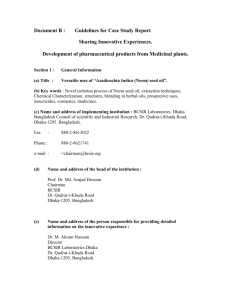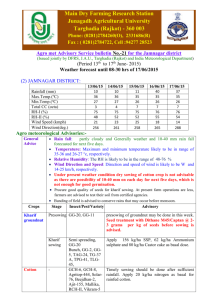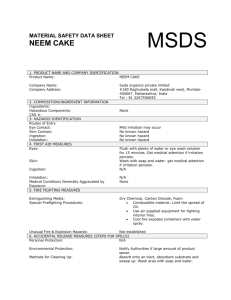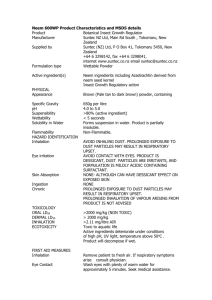NeemAgents - Computer Science
advertisement
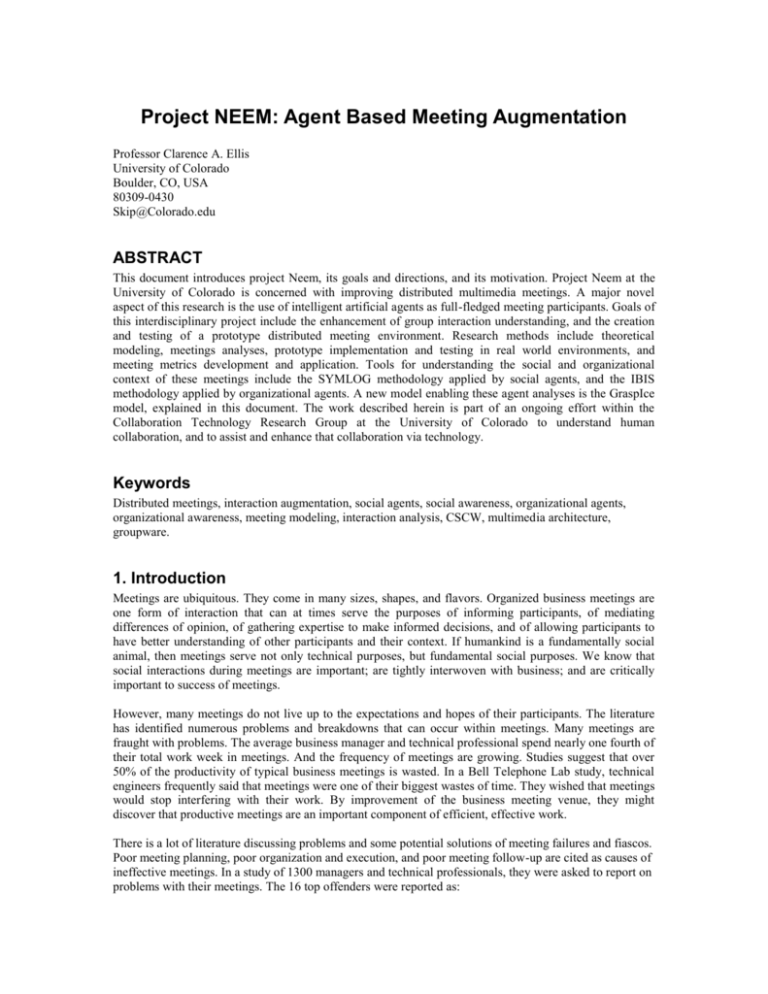
Project NEEM: Agent Based Meeting Augmentation Professor Clarence A. Ellis University of Colorado Boulder, CO, USA 80309-0430 Skip@Colorado.edu ABSTRACT This document introduces project Neem, its goals and directions, and its motivation. Project Neem at the University of Colorado is concerned with improving distributed multimedia meetings. A major novel aspect of this research is the use of intelligent artificial agents as full-fledged meeting participants. Goals of this interdisciplinary project include the enhancement of group interaction understanding, and the creation and testing of a prototype distributed meeting environment. Research methods include theoretical modeling, meetings analyses, prototype implementation and testing in real world environments, and meeting metrics development and application. Tools for understanding the social and organizational context of these meetings include the SYMLOG methodology applied by social agents, and the IBIS methodology applied by organizational agents. A new model enabling these agent analyses is the GraspIce model, explained in this document. The work described herein is part of an ongoing effort within the Collaboration Technology Research Group at the University of Colorado to understand human collaboration, and to assist and enhance that collaboration via technology. Keywords Distributed meetings, interaction augmentation, social agents, social awareness, organizational agents, organizational awareness, meeting modeling, interaction analysis, CSCW, multimedia architecture, groupware. 1. Introduction Meetings are ubiquitous. They come in many sizes, shapes, and flavors. Organized business meetings are one form of interaction that can at times serve the purposes of informing participants, of mediating differences of opinion, of gathering expertise to make informed decisions, and of allowing participants to have better understanding of other participants and their context. If humankind is a fundamentally social animal, then meetings serve not only technical purposes, but fundamental social purposes. We know that social interactions during meetings are important; are tightly interwoven with business; and are critically important to success of meetings. However, many meetings do not live up to the expectations and hopes of their participants. The literature has identified numerous problems and breakdowns that can occur within meetings. Many meetings are fraught with problems. The average business manager and technical professional spend nearly one fourth of their total work week in meetings. And the frequency of meetings are growing. Studies suggest that over 50% of the productivity of typical business meetings is wasted. In a Bell Telephone Lab study, technical engineers frequently said that meetings were one of their biggest wastes of time. They wished that meetings would stop interfering with their work. By improvement of the business meeting venue, they might discover that productive meetings are an important component of efficient, effective work. There is a lot of literature discussing problems and some potential solutions of meeting failures and fiascos. Poor meeting planning, poor organization and execution, and poor meeting follow-up are cited as causes of ineffective meetings. In a study of 1300 managers and technical professionals, they were asked to report on problems with their meetings. The 16 top offenders were reported as: 1. 2. 3. 4. 5. 6. 7. 8. 9. 10. 11. 12. 13. 14. 15. 16. getting off the subject no goals or agenda too lengthy inadequate preparation inconclusive disorganized ineffective leadership irrelevance of information discussed time wasted during meeting starting late not effective for making decisions interruptions individuals dominate / aggrandize discussion rambling, redundant, or digressive discussion no published results or follow-up action no pre-meeting orientation Compounding this is the obvious, and huge toll of travel to / from meetings. Given that most large organizations are distributed, and many are multinational, the time and money invested in meeting travel is considerable. If effective distance meetings could replace this travel, then much savings would accrue. The rapid growth of Internet availability, and personal computers has lead to the desktop conferencing phenomenon. Organizations that have tried this in the past have met with very limited success. The Neem project is addressing meetings, and meeting improvement within a distributed setting. If successful, it can represent a significant step forward. Especially, recent studies of distributed organizations show that attempts to conduct significant business via distributed, technologically augmented meetings frequently fail to produce the desired results [Begeman]. Adequate understanding of meeting factors and meeting metrics in distributed situations is noticeably lacking. This is an area needing further research. For example, it is sometimes the case that participants at a meeting convey their agreement, pleasure, or confusion via facial expressions and body language. However in many distributed meetings, these communication elements are lost. Our prototype system provides alternative channels to allow communication elements such as these and others to be available. This document is fundamentally concerned with business meetings and their improvement / augmentation. It describes project Neem, a research project ongoing within the Collaboration Technology Research Group at the University of Colorado aimed at understanding some of the social, structural, and organizational factors at play within medium size distributed business meetings. The organization of this document is as follows: Section 2 discusses related work and our philosophy. Section 3 presents a scenario of the Neem system in action. Section 4 presents our theoretical framework. Section 5 discusses the Neem functionality and tools. Section 6 discusses the Neem architecture. Section 7 discusses our agent technology. Section 8 presents our summary and conclusions. 2. Related Work and Our Philosophy Over the years, there have been a large number of efforts to improve meetings. Large gatherings in many settings and societies have found that there must be structures to enable effective interaction. Even in primitive societies, societal norms included who could speak, and who could perform certain actions at group meetings [xxx]. There is an acknowledged need for agreed upon structures and protocols in large meetings. Robert’s Rules of Order were conceived to help fulfill this need. As soon as reliable computing technology became available, experiments began with electronic blackboards, and other meeting assistance technology. The field of GDSS (Group Decision Support Systems) has built technology, and studied its effect within face to face meetings. Many meeting room tools have now matured, and found good utility within meetings. Previous meeting technology research 2 work was performed at MCC during the 1980s; co-author Ellis was head of that effort. That effort was enlightening, and successfully applied technology, but did not attack distributed meetings, and did not employ agents. In recent times, numerous companies have presented offerings to allow distance meetings to transpire over the Internet. Netmeeting and Placeware are interesting examples of product offerings ranging from local software to full service meeting control centers. Our project Neem endeavors to take the next step by incorporating active augmentation within distributed meetings. Active augmentation is needed we claim because … Our philosophy includes a belief in active meeting augmentation, and a belief that well researched, well thought out technology can truly make a significant positive difference. Specifically we think that different functionality and goals can coexist within a meeting. For example, there should be a healthy tension between fast pace (efficiency) and careful quality of interaction (effectiveness); likewise, between convivial agreement and critical questioning of assumptions. Different perspectives can conveniently be represented in Neem as different roles played by different participants – some automated agents. For example a social agent may want to take time to enjoy side discussion that informs all; as opposed to an organizational agent that may urge the group to keep on its scheduled agenda, and to keep on time. Our Neem hypothesis includes the statement that agents should be full fledged participants in all meetings of the group. They can help add continuity, and perspectives. In keeping with this hypothesis we want each agent to have sensors (e.g. spoken language understanding unit) and effectors (e.g. spoken output directed to the group). The center for spoken language research (CSLR) at the University of Colorado has produced excellent base technology for this, and is our partner in Neem research. Although they will be clearly and obviously identified as non-human, we want our agents to be anthropomorphic and anthropomorphic. Ideally these agents will be able to detect emotion in others, and to express emotion. Agents will not be dictators, but tunable meeting assistants. The team involved in this research work resides within computer science, business systems, cognitive science, communications, artificial intelligence, anthropology, and other disciplines. Our research work is quite interdisciplinary, and builds upon work of many colleagues and forerunners. One of the investigators recalls experiences in the 1960 with Weisenbaum’s Eliza program. The Eliza agent simulated a psychiatrist (via a terminal typing interface), but actually had minimal understanding of the real world objects being discussed by the patient. Eliza was never-the-less successful in guiding the conversation, and giving the participant a feeling of being heard. In a similar fashion, our goal is to implement a set of multimedia meeting agents that collect meeting data, have a small understanding of the meeting, and have high impact in steering the distributed meeting in good directions. Foundations upon which we build include the following: MCU technology and distance meeting architecture work (we extend via whisper, etc) Spoken language processing systems (CSLR is big on this at Colorado) Folk literature of meeting improvement tips; more formal stuff like Roberts rules of Order. GDSS literature reports on face-to-face meeting room technology and its evaluation (Zigurs!) Distance meeting technologies – teleconferencing, videoconferencing, desktop conferencing Studies of distributed meetings and interactions Social theories of interaction adapted to distributed meetings (e.g. Bales) Organizational theories adapted to distributed meetings (e.g. ???) Interacting agents theories and knowledge networks and DAI Group user interfaces Socially intelligent agents and social computing Distributed meeting metrics; meeting technologies evaluation 3. A Scenario 3 The following scenario of a program committee paper selection committee illustrates some of the functionality, the technology, the support level, and the interaction interface that we envision for our Neem prototype. In this scenario, papers that have been submitted to a conference are in the process of being evaluated at a distributed real time program committee meeting. This meeting will be followed by asynchronous interaction using electronic decision tools to evaluate the borderline papers. The follow-up interaction includes paper evaluation conversations that involve all interested program committee members (anonymous) and paper authors and also our automated agents. The technology and the agents augment the meeting, as well as the pre- and post- meeting activities. In this example, there are three artificial agents with voice input/output capabilities: (1) Kwesi – an information agent; (2) Kwabena – a social agent; (3) Kwaku – an organizational agent The program committee meeting involves committee members who connect to the web-based workware system from their home or office at a designated time. Simple desktop conferencing tools include whiteboard, multimedia chat tool, audio (and potentially video) tools, shared artifact viewers, a whisper function, and conversation tools. Fancier set-ups, including real-time animation of 3-D models, will also be pursued in later versions of the system. All participants view and manipulate various conference documents and lists. For example, upon login, all participants see a virtual conference room and conference table with icons of all participants that are present and their roles shown graphically. An agenda tool lists the items to be discussed during the meeting and time estimate bars for each item. As the meeting progresses, actual time bars accumulate next to each item. Thus participants can see at a glance how much time has been allocated to each item (and how much time was supposed to be allocated) in real time during the meeting. Submitted papers are discussed and categorized one by one. In the case of one controversial paper, the program committee, after its deliberations, receives a (spoken) message from agent Kwesi; he has searched 350 web sites and found several published documents on the exact topic of the submitted paper. None of the program committee members had been aware of these documents. The documents substantiate that this is a very important topic, and also that the topic is not a completely new one. Given this finding, the program committee decides to move this paper to the category of “deferred” until they have reviewed the related documents after the meeting. They thank Kwesi and move on to discussion of the next paper. This is an example of a research agent that is willing to spend hours searching out relevant information. Given the ever-increasing volume of information on the Internet, this is a very valuable agent. After a while, the social agent, Kwabena, suggests that the committee has been working diligently for two hours, and people might like to take a break. Kwabena also notes that several participants have expressed this wish by pushing their “break time” buttons. The user interface for all participants presents half a dozen soft buttons such as the “I would like to speak” and the “break time” buttons. Any of these buttons can be pushed using the mouse by any participant at any time. Everyone agrees to take a 15 minute break. Kwabena also suggests a “get-acquainted game” that can be played by participants during the break. Committee members laugh at this and decline. Unlike a typical human, Kwabena is never offended by being over-ruled. Kwabena is tunable; whenever the program committee feels that Kwabena is interrupting too much, they can turn down Kwabena’s interaction quotient via another button. This is an example of a social agent that attempts to be responsive to the sensitivities of the group, and that is controllable by the group. After the break, roll call is again taken, and the future vision papers are evaluated. Numerous virtual reality papers have been submitted; they are quickly rejected. Kwabena suggests that the program committee hear from John, who (Kwabena discovers from the program committee profile pages) is a virtual reality specialist; he has not had a chance to speak during the meeting. John points out some strengths and weaknesses of various papers, and advocates one particular virtual reality paper. He recommends that although there are minor flaws, it should be accepted. It would be stimulating and more balanced if virtual reality had some representation within the conference, John says. It is decided to take this issue into an 4 asynchronous interaction mode so that people will have time to do some reading and some reflection. People will then contribute their opinions using the asynchronous gIBIS tool [Conklin92]. The meeting comes to a close. The chair thanks everybody. Kwaku reminds all of rapidly approaching deadlines, and asks everyone to check the online issue base frequently. Participants then fill out an online questionnaire to evaluate the interaction. Meeting minutes, including action items, are instantly available. Important interactions continue after the meeting in an asynchronous fashion. 4. Theoretical Foundations There are various social / organizational science theories that can inform the agents in their meeting augmentation. Most of these theories can fit within our Neem theoretical framework that we describe next. In this section we also describe a particular social theory (SYMLOG), and a particular organizational theory (IBIS) imbedded within our first prototype. 4a. Theoretical Framework Many of the issues and entities dealt with inside a meeting are concerned with group goals, resources, and activities. Our GraspIce model captures these concepts as well as other relevant ones. We labeled this model GraspIce because these letters are the initials of important entities of each and every meeting; also understanding, analyzing, and augmenting meetings is as slippery as grasping ice. The entities of our model are listed below. A GraspIce Model is an 8-tuple, M = <G, R, A, S, P, I, C, E> where G = Goals R = Resources A = Activities S = Structures P = Participants I = Information C = Context E = Exogenous factors The set G of goals can include group goals (e.g. select best submitted papers to appear in conference), as well as subgroup and individual goals (e.g. get to know people and literature in the groupware domain). Some of these goals may be explicit and open. Others may not. Note that meetings frequently involve conflicting goals (especially group goals may conflict with personal goals). The set R of resources can include conceptual as well as physical resources. Physical resources of a meeting may include whiteboard, meeting table, and meeting room if it is face-to-face. Conceptual resources that may be equally as important as physical ones include meeting ambiance and participant intuition. A computer based distributed meeting requires resources such as communications medium (e.g. telephone lines), computer hardware (e.g. high resolution screen) and software (e.g. screen sharing programs). A meeting always involves a set of activities that constitute the “happenings” of the meeting. In some cases, we are interested in modeling the macro tasks that occur. Each voting activity can result in important conflict resolution. In other cases we attempt to capture and analyze micro acts that occur. In the micro ethnography, each utterance and each non-verbal act is examined to understand the social structures and barometer of the group. Structures represent relationships between goals, resources, information, activities, etc. The mapping between goals and the resources needed to attain them is one example (e.g. printer needed to obtain meeting minutes). Some structures are imposed within a set. For example, the discussion activity must be structured to always occur before the voting activity. 5 Certain resources are singled out to be independent elements of our model because they are fundamental elements. One type of resource of paramount importance is people! Thus we have a category labeled participant that includes all individuals, subgroups, and artificial agents. One structure relevant to this set is the roles played by various participants. The set I of information elements is an important resource set that is retrieved, shared, bartered, and generally highly valued. Information technology is especially designed to deal with this set. These elements are also crucial in attaining certain goals. The set C of context elements strongly effects meeting interactions. In a conflict resolution meeting, there may be a context involving tension and hostility that may not be present in collaborative discussion meeting. Social and organizational context are also potential determiners of meeting outcome. If my organization is losing money, and facing eminent destruction, this is a very different context than a rich successful start-up. A model is defined as a simplified approximation to a reality. Therefore, there are always many factors and elements that are explicitly not included in any model. These elements that are not linked into the structures of the model are put into the category of exogenous factors. Exogenous means that they are outside of the scope of the current model and analysis. Together the above eight sets of elements provide a framework within which many theories and models can be described and categorized. Next we give a brief explanation of a social theory (Bales SYMLOG) and an organizational theory (Riddle’s IBIS) that we are employing in our first Neem prototype. The SYMLOG theory is especially concerned with participants, activities, and context; whereas the IBIS theory is especially concerned with information, goals, and structures. Note that our Neem approach and systems are independent of any particular social or organizational theory. We hope that groups will ultimately be able to flexibly define their own theories and interaction protocols. 4b. Social Theory Issues One set of issues is concerned with the adequacy of formal social theories to address pragmatic problems of group communication and interaction. Also we are concerned with possibilities of imbedding these social theories within systems. One of the theories that is well known and respected in the social psychology field is Robert Bales’ Social Interaction Systems Theory which we briefly introduce here. In a previous section, we presented a scenario that suggested how a theory such as this one can be usefully imbedded in distributed meeting technology via an agent such as Kwabena. Social Interaction Systems Theory presents a theory of small group interaction, as well as a methodology for observation, codification, and analysis of small group face to face meetings. It attempts to capture and interpret micro level acts – both verbal and non-verbal – within a group interaction, typically for the purpose of improving group productivity and satisfaction. Since the early 1940s, Bales and colleagues within the Laboratory for Social Studies, and within the Department of Psychology at Harvard University have studied small group social interaction via direct observation, controlled experiments, academic selfanalytic groups, and business teams. They have published a large number of research papers and books on this topic. The Social Interaction Systems Theory work also has pragmatic thrusts; for example the Harvard spin-off company SCG, begun in 1983, has an applied methodology and a computerized suite of analysis instruments that analyze Bales SYMLOG questionnaires, scorings, and/or ratings to produce ‘field diagrams’ which are graphical pictures and written reports summarizing and evaluating a group’s meeting interactions. Characteristics measured by the SYMLOG methodology include the following bipolar dimensions: 1. Dominance versus Submissiveness; 2. Friendliness versus Unfriendliness; and 3. Acceptance versus Non-acceptance of Authority. 6 The frequency rates with which an individual behaves in each of these kinds of ways, or implies that a given kind of behavior is good or bad, can be observed and plotted on a scale of frequency and intensity. These observations can be recorded by all members of the group on Bales rating forms or by trained observers using scoring forms. The collected information can be used in SYMLOG analysis to predict likely group trends such as the formation of opposition subgroups, scapegoats, group leaders, group mediators, or group polarizations. Although the behavior of individual in groups is idiosyncratic and highly variable, there are numerous reports of success of Social Interaction Systems Theory and SYMLOG analyses. Social Interaction Systems Theory continues to be an active area of research. One unexplored direction of research is the application of Social Interaction Systems Theory to distributed groups. 4c. Organizational Issues One set of issues is concerned with the adequacy of organizational models. How do we intend to apply these models within our workware systems. The scenario previously presented gives concrete examples of application possibilities via the participant, Kwesi. One of the models that is well known and respected in the field is Horst Rittel’s Issue Based Information Systems (IBIS) which we briefly introduce here. The IBIS method [Rittel70], developed over 30 years ago, is based upon the principle that the design and solution process for complex problems, which Rittel called “Wicked Problems,” is fundamentally a conversation among the stakeholders (e.g. designers, customers, implementers) in which they bring their respective expertise and viewpoints to the resolution of design issues. Any problem, concern, or question can be an issue, and may require discussion (if not agreement) in order for the design to proceed. Indeed, in the IBIS model, it is this “argumentation” which constitutes the design process, and which yields the group memory of the rationale for decisions. The IBIS model focuses on the articulation of the key Issues in the design problem. Each Issue can have many Positions. A Position is a statement or assertion that potentially resolves the Issue. Often Positions will be mutually exclusive of each other, but the method does not require this. Each of an Issue’s Positions, in turn, may have one or more Arguments that either support that Position or object to it. Thus each separate Issue is the root of a (possibly empty) tree, with the children of the Issues being Positions, and the children of the Positions being Arguments. We are applying this model within our meetingware system by creating a graphical IBIS that allows any authorized conference committee member to read and post issues, positions, and arguments at any time using their web connection. Thus, a typical IBIS discussion might begin by the committee chair posting an Issue node containing the question “Who should we invite as the Keynote Speaker?” That person may also post a position node proposing one person as speaker, and may also post some argument nodes supporting the choice of that person. Others may then post other Positions and Arguments that support or object to any of the positions. In addition, new Issues raised by the discussion may be posted at any time and linked into the nodes that most directly suggested them. These postings serve as an organizational memory that not only captures the final decisions when trees are “closed,” but also shows the history of alternatives explored, and rationale [Conklin88]. Evaluation Issues A significant issue is the evaluation of the committee interactions, and the prototype workware system. We are exploring an evaluation framework that basically consists of a technology space (T-space), an actor space (A-space), and an interaction space (I-space). The framework supports evaluation via a set of fuzzy mappings between these spaces. See [Ellis2000] for more detail. Besides the usual metrics of efficiency and effectiveness, we are particularly interested in the metric that we call “group positioning.” As one example, a great decision meeting that alienates the participants may be judged excellent on the efficiency and effectiveness dimensions, but very poor on the group positioning dimension because the group may quickly dissolve itself. 7 5. Agents and Abilities A key theme of our Neem system is its use of active, anthropomorphized agents as full-fledged meeting participants. Every agent has input capabilities (sensors), computational capabilities, and output capabilities (effectors). Agents have roles, functionalities called abilities, and visible characteristics called personalities. Agent actions are driven by their goal sets. Different agents typically have different goal sets. These sets may be disjoint or overlapping. Thus, different agents may have common goals, and may also have conflicting goals. For example, Kwesi has goals of keeping the meeting on time, and keeping discussion focused upon the specified agenda. He keeps track of time, of who speaks, and of the agenda. If the meeting falls behind time, then Kwesi discourages informal chit chat about peripheral topics. Kwabena has a goal of building common ground among participants, and knows that informal discussion about peripheral topics is important for this. Thus there are conflicting goals here. Agents have voices, so the result in this situation may be two spoken statements to all participants. In a strong voice, Kwesi says “Hey gang, we are behind time! Lets move on to the next agenda item.” In a gentle voice, Kwabena says “You all know its important for us to have a common understanding of our team assumptions and direction. Whenever necessary, please take time to have clarifying discussions.” Our agents have various abilities, implemented by a nested elves architecture. The details of this architecture are beyond the scope of this paper, and are documented elsewhere. One consequence of this is that agent inputs may include feedback, i.e. observation and estimation of the effect of their actions upon the group. Of course other agents are members of the group, so instead of independent statements evoked by the two agents in the above example, the agents might coordinate, negotiate, and decide to NOT speak until after the chit-chat has continued for more than some agreed upon amount of time (e.g. 10 minutes). A major thrust of our Neem research is to explore functionality to assist in normal meeting tasks. At times, certain functionality is best provided by non-embodied passive tools rather than agents. Various tools that are available to users provide information, and in some cases an expression outlet, for users. According to the roles played by various participants, the information may be available to some, and not to others. For example, one could envision a talk queue that optionally appears on every user’s screen. The queue is visible only if a user opens it, and can optionally be used by anyone to put their name into the queue of participants waiting to speak to the group. It provides background information that is available to users and to agents, but does not actively push this information onto users conscious foreground. It also provides an expression outlet for users that want to speak. There are positive and negative aspects of implementing this functionality as a passive tool rather than as an agent. I can indicate that I have something to say without interrupting the current spoken flow of the meeting. Other functionality may be best provided by active ground. Consider the mood buttons tool implemented by the Neem user interface. Any user, at any time, can push any of the mood buttons on their screen. Buttons have labels such as “I am confused” and “need-a-break” and “this discussion is very upsetting to me.” The tool will store button push information in some data store. Should this information be made available to the current speaker? Neem will explore various choices, such as making this available to analysts after the meeting only; or making this instantly available to selected administrative roles only (e.g. the social agent, Kwabena); or making this part of the active ground available to all participants in real time. The conversation analysis literature has discussed the concept of common ground. In the Neem project, we are experimenting with the notion of active ground. Active ground is knowledge and shared culture that is normally in the background (exogenous context) that is actively brought to the appropriate users’ attention when certain thresholds are exceeded. In this example, there might be colored mood globes that are visible in the background on users’ screens. Using the interaction analysis theory of Bales, the globe might change colors as the meeting progresses in informative ways. For example, as the discussion “heats up” and becomes argumentative for some people, portions of the globe turn orange, then red. 8 In summary, agents are active, visible, and have human-like characteristics such as voices for speaking up at any time during the meeting. We discussed in this section, notions of agent abilities, personalities, and goals. In contrast, Neem tools are user interface objects that are passive. Active ground objects are not agents, but they are active. Tools are described more in the next section. 6. Summary and Conclusion This document has introduced project Neem, its goals and directions, and its motivation. Project Neem at the University of Colorado is concerned with improving distributed multimedia meetings. A major novel aspect of this research is the use of intelligent artificial agents as full-fledged meeting participants. We are working with groups of consenting conference organizers as our test bed. We will utilize interviews, questionnaires, and videotaped observations of their actions and interactions to assess our prototypes. The meetingware system also collects information and measurements about one to one communications, and subgroup interactions. Techniques appropriate for analysis of this thrust include organizational analysis, distributed cognition studies, questionnaires, interviews, observation, technology usage analysis, and cognitive walkthroughs. With this data, it is possible to perceive the existence of cliques, of gatekeepers, and of patterns of communication. It is possible to estimate the cohesiveness of the groups and other salient characteristics using theories from the social network analysis domain. The results of these analyses will be useful within our ongoing systems and agents design. We believe the time is ripe for a spectacular success in a similar fashion to the Eliza agent success, but in the distributed group interaction domain. With minimal domain knowledge, our agents will coax and steer the meetings in positive directions. If our hypotheses of active meeting augmentation and anthropomorphic agents are validated then this could open the door to enormously more effective distributed meetings. REFERENCES 1. 2. 3. 4. 5. 6. 7. 8. 9. 10. 11. 12. 13. 14. Arias, E. G., G. Fisher, & H. Eden, “Enchancing Communication, Facilitating Shared Understanding, and Creating Better Artifacts by Integrating Physical and Computational Media for Design,” Symposium on Designing Interactive Systems, pp. 1-12, 1997. Bales, R. F. Interaction Process Analysis: A Method for the Study of Small Groups, AddisonWesley, Cambridge, Mass., 1950. Bales, R. F. & S. P. Cohen, SYMLOG: A System for the Multiple Level Observation of Groups, The Free Press, N.Y., 1979. Bouchard, T. J., & M. Hare, “Size, Performance, and Potential in Brainstorming Groups,” Journal of applied Psychology, 54(1), pp. 51-55, 1970. Conklin, J., “Capturing Organizational Memory,” Proceedings of the Groupware’92 Conference, Coleman D., (ed.), Morgan Kaufmann Publishers, pp. 133-137, 1992. Cummings, L. L., G. P. Huber, & E. Arendt, “Effects of Size and Spatial Arrangement on Group Decision Making,” Academy of Management Journal, 17(3), pp. 460-475, Semptember, 1974. Dautenhahn, K. (ed.), “Socially Intelligent Agents: Humans in the Loop,” Proceedings of the Fall 2000 AAAI Symposium, TR-FS-00-04. AAAI Press, November 2000. Doyle, M., & D. Straus, How to Make Meetings Work, Jove Publishings, 1985. Ellis, C., “An Evaluation Framework for Collaborative Systems-Report to NTT Tech. Group,” University of Colorado CS Report CU-CS-109-99, 1999. Ellis, C., “Team Automata,” Proceedings of the ACM Group’97 Conference, November 1997. Ellis, C., Begeman, M., et.al., “Meetings Augmentation and Analysis” Proceedings of the First MCC/ACM CSCW Conference, 1986. Engelbart, D. C., “Towards Augementing the Human Intellect and Boosting Our Collective IQ,” Communications of the ACM, pp 30-33, August 1995. Fisher, G., “Domain-Oriented Design Environments,” Automated Software Engineering, 1(2), pp. 177-203, 1994. Gordon, M., How to Plan & Conduct a Successful Meeting, Sterling Publishing Co, Knopf, New York, 1985. 9 15. Hare, A. P., E. F. Borgatta, & R. F. Bales, (eds.), Small Groups: Studies in Social Interaction, Knopf, New York, 1955. 16. Hentschel, G. C., “There’s a Method in the Magic: The Nominal Group Process,” Lifelong Learning, 8(3), pp. 11-14, November 1984. 17. Homans, G. C., The Human Group, Harcourt Brace, New York, 1950. 18. Huber, G. P., “Issues in Design of Group Decision Support Systems, “ MIS Quarterly, pp. 195204, September 1984. 19. Janis, I. L., Victims of Groupthink, Houghton Mifflin, Boston, 1972. 20. Jebara, T., et. al., “Tracking Conversational Context for Machine Mediation of Human Discourse,” Proceedings of the Fall 2000 AAAI Symposiium on Socially Intelligent Agents, TRFS-00-04, AAAI press, November 2000. 21. Johansen, R., J. Vallee, & K. Spangler, Electronic Meetings, Addison-Wesley, Reading Mass., 1979. 22. Keddara, K., Dynamic Evolution in Workflow Systems, Ph.D. Thesis, University of Colorado, September 1999. 23. Konsynski, B. R., J. E. Kottenmann, et. al.,”PLEXSYS-84: An Integrated Development Environment for Information Systems,” Journal of Management Information Systems, 1(3), pp. 63-104, Winter 1984-85. 24. Konsynski, B. R., “The University of Arizona’s Planning Laboratory,” Department of Management Information Systems Document, College of Business and Public Administration, University of Arizona, 1986. 25. Knapik, Michael & Jay Johnson, Developing Intelligent Agents for Distributed Systems, McGrawHill, 1998. 26. Meyer, N.D., & J. C, Bulyk, “Augmented Meeting Support: Increasing Executive Effectiveness,” Information Strategy: The Executive’s Journal, pp. 24-29, 1886. 27. Murch Richard & Tony Johnson, Intelligent Software Agents, Prentice-Hall Inc, New Jersey, 1999. 28. Picard, R. W., Affective Computing, The MIT Press, Mass., 1997. 29. Sherif, M., & C. W. Sherif, Groups in Harmony and Tension, Harper, New York, 1953. 30. Stogdill, R. M., Individual Behavior and Group Achievement, Oxford University Press, New York, 1959. 31. Thibout, J. W., & H. H. Kelley, The Social Psycholoogy of Groups, Wiley, New York, 1959. 32. Zander, A. F., Making Groups Effective, Jossey Bass, San Francisco, 1982. 10

